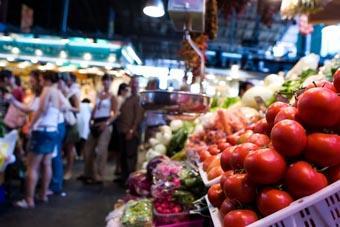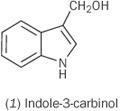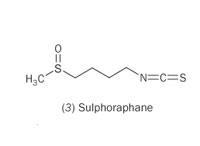Simon Cotton takes a look at those compounds that find themselves in the news or relate to our everyday lives.
In this issue: Eat your greens.

Why?
In recent years, tests have shown that vegetables of the crucifer family, which includes broccoli, cabbage, Brussels sprouts and cauliflower, contain molecules that can fight all sorts of diseases.

Such as?

Broccoli is rich in indole-3-carbinol (1). This chemical suppresses a protein that speeds up growth of cancer cells. The body converts indole-3-carbinol into 3,3'-diindolylmethane (2), and this is known to inhibit growth of prostate cancer cells. These compounds have also been shown to reduce the incidence of tumours caused by hydrocarbons like benzpyrene - a lung cancer-causing molecule - and also appear to have potential against other tumours, like breast cancer.
What other useful molecules does broccoli contain?
Cruciferous vegetables like broccoli contain high levels of glucosinolates. The plants store these as defense compounds. When plant cells are damaged by a herbivorous predator (or vegetables eaten by us), the enzyme myrosinase comes into contact with the glucosinolates, which are hydrolysed to isothiocyanates.

What do they do in the body?

Isothiocyanates are among the most powerful anticancer agents in the diet, inhibiting the action of carcinogens in various parts of the body especially in colorectal and lung cancers. Sulphoraphane (3) (4-methylsulphinylbutyl isothiocyanate) is an important member of this family. Jed Fahey and his team at John Hopkins University have shown that this compound inhibits antibiotic-resistant Helicobacter pylori, which causes peptic ulcers and can lead to stomach cancers. Studies have shown that the isothiocyanates also kill breast cancer cells and stop growth in some leukaemia and melanoma cells. Research by Paul Talalay, also at John Hopkins University, shows that sulphoraphane may also protect the eyes against macular degeneration (a leading cause of blindness among elderly people) by protecting retinal pigment cells. Scientists at the Institute of Food Research are now developing a 'super-broccoli' with higher levels of sulphoraphane.
Are green vegetables the only source of isothiocyanates?
Phenethyl isothiocyanate (R = C6H5CH2CH2-) is found in watercress and allyl isothiocyanate (R = CH2=CHCH3-) is an important component of mustard oil, both of which have antitumour activity. These isothiocyanates produce irritation and inflammation by activating TRP (transient receptor potential) channels in sensory nerve endings, just as capsaicin found chilli peppers does. This is why watercress and mustard are pungent. Cancer Research UK advise a healthy balanced diet, which should include at least five portions a day of a variety of fruit and vegetables, is the best way to reduce your risk of many cancers.






No comments yet